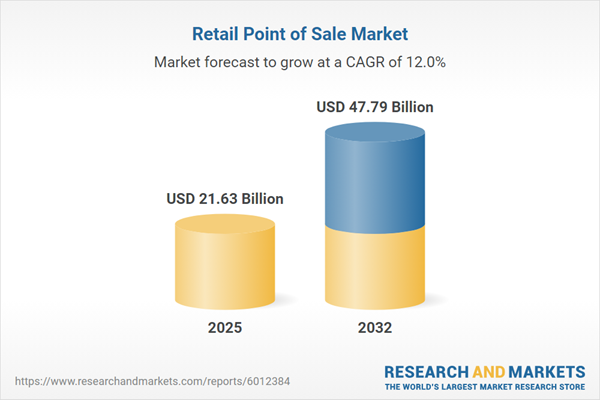Speak directly to the analyst to clarify any post sales queries you may have.
The global retail point of sale market is evolving rapidly, driven by digital transformation and shifting consumer interactions. Senior executives increasingly prioritize adaptable technology frameworks to support business agility and sustained competitiveness.
Market Snapshot: Retail Point of Sale Market Size & Growth
The retail point of sale market continues its upward trajectory, with a global valuation of USD 19.26 billion in 2024. Projected to reach USD 21.63 billion by 2025 and expand at a compound annual growth rate (CAGR) of 12.02%, the sector is on track for an estimated value of USD 47.79 billion by 2032. Ongoing advances in POS systems, driven by the need for efficient response to evolving consumer behaviors, improved payment security, and actionable analytics, are fueling this momentum. Retailers are modernizing their operations by integrating digital payment capabilities and adopting unified platforms that streamline both in-store processes and the customer journey.
Scope & Segmentation: Strategic Insights for the Retail Point of Sale Market
This comprehensive report equips executive teams to optimize investment and align technology strategies at every operational level. The segmentation framework covers critical dimensions shaping market growth and operational excellence:
- End User Types: Supermarkets, convenience stores, hospitality businesses, digital-first retailers, and brick-and-mortar stores each utilize specialized POS architectures designed to maximize workflow efficiency and customer experience.
- Deployment Modes: Cloud-based, hybrid, and on-premise solutions cater to varying requirements for scalability, centralized data oversight, and resilience as digital infrastructures advance.
- Organization Sizes: Large enterprises and small to medium-sized retailers benefit from solutions tailored to enhance operational maturity and technology adoption, regardless of business scale.
- Component Categories: Deployments integrate POS terminals, printers, registers, payment software, analytics tools, and ongoing maintenance services, reinforcing reliability and enabling data-informed business decisions.
- Regional Coverage: Analysis spans the Americas, Europe, Middle East & Africa, and Asia-Pacific, revealing how regulatory variants, payment preferences, and consumer trends direct market strategies and unlock expansion opportunities.
- Technologies Covered: Contactless payment solutions, API integrations, AI, blockchain, cloud analytics, and augmented reality technologies play a significant role in supporting secure, agile retail operations.
- Leading Providers Analyzed: Profiles and comparisons focus on Block, Inc., NCR Corporation, Fiserv, Worldline S.A., PAX Technology Limited, Toshiba Tec Corporation, Shopify Inc., Verifone Systems, Lightspeed Commerce Inc., and Oracle Corporation, examining each provider’s approach to product leadership and innovation.
Key Takeaways: Executive Insights for Decision Makers
- Unified omnichannel POS platforms establish consistent brand experiences across both digital and physical retail environments, supporting integrated engagement strategies.
- Flexible deployment models empower organizations to adapt rapidly to operational changes and maintain compliance with diverse regulatory environments.
- Partnerships with technology and fintech leaders drive advanced loyalty programs and strengthen digital marketing initiatives, helping retailers generate additional business opportunities.
- Modular, open-API POS hardware and software structures support future upgrades and protect technology investments, ensuring efficient scaling and long-term cost management.
- Integrating blockchain and augmented reality elevates transactional security and opens new avenues for customer interaction and engagement within retail spaces.
- Holistic integration of POS with supply chain and workforce management improves operational visibility and enables optimized staff performance throughout retail operations.
Tariff Impact and Regulatory Considerations
- Changes in tariff regulations necessitate ongoing assessment of hardware sourcing and supplier selection, promoting the adoption of responsive and adaptable procurement strategies.
- Automated compliance solutions improve transparency across complex supply chains and help retailers adapt swiftly to evolving regulatory requirements.
Methodology & Data Sources
This market research leverages in-depth secondary analysis, structured interviews with senior retail executives, and insights from subject matter experts. Triangulated data validation and scenario modeling underpin the report’s comprehensive and authoritative perspective on market priorities and risks.
Why This Report Matters
- Presents clear, actionable guidance for evaluating and integrating POS systems, tailored to each organization’s operational goals and compliance landscape.
- Highlights the pivotal role of unified POS platforms and advanced payment technologies in driving service quality and business flexibility.
- Empowers leaders with strategic perspectives for effective risk oversight, cost control, and informed technology investment.
Conclusion
This report provides retail decision-makers with practical benchmarks and targeted insight, fostering confident investment and strategic direction for next-generation point of sale solutions.
Additional Product Information:
- Purchase of this report includes 1 year online access with quarterly updates.
- This report can be updated on request. Please contact our Customer Experience team using the Ask a Question widget on our website.
Table of Contents
3. Executive Summary
4. Market Overview
7. Cumulative Impact of Artificial Intelligence 2025
List of Figures
Companies Mentioned
The companies profiled in this Retail Point of Sale market report include:- Block, Inc.
- NCR Corporation
- Fiserv, Inc.
- Worldline S.A.
- PAX Technology Limited
- Toshiba Tec Corporation
- Shopify Inc.
- Verifone Systems, LLC
- Lightspeed Commerce Inc.
- Oracle Corporation
Table Information
| Report Attribute | Details |
|---|---|
| No. of Pages | 185 |
| Published | November 2025 |
| Forecast Period | 2025 - 2032 |
| Estimated Market Value ( USD | $ 21.63 Billion |
| Forecasted Market Value ( USD | $ 47.79 Billion |
| Compound Annual Growth Rate | 12.0% |
| Regions Covered | Global |
| No. of Companies Mentioned | 11 |









